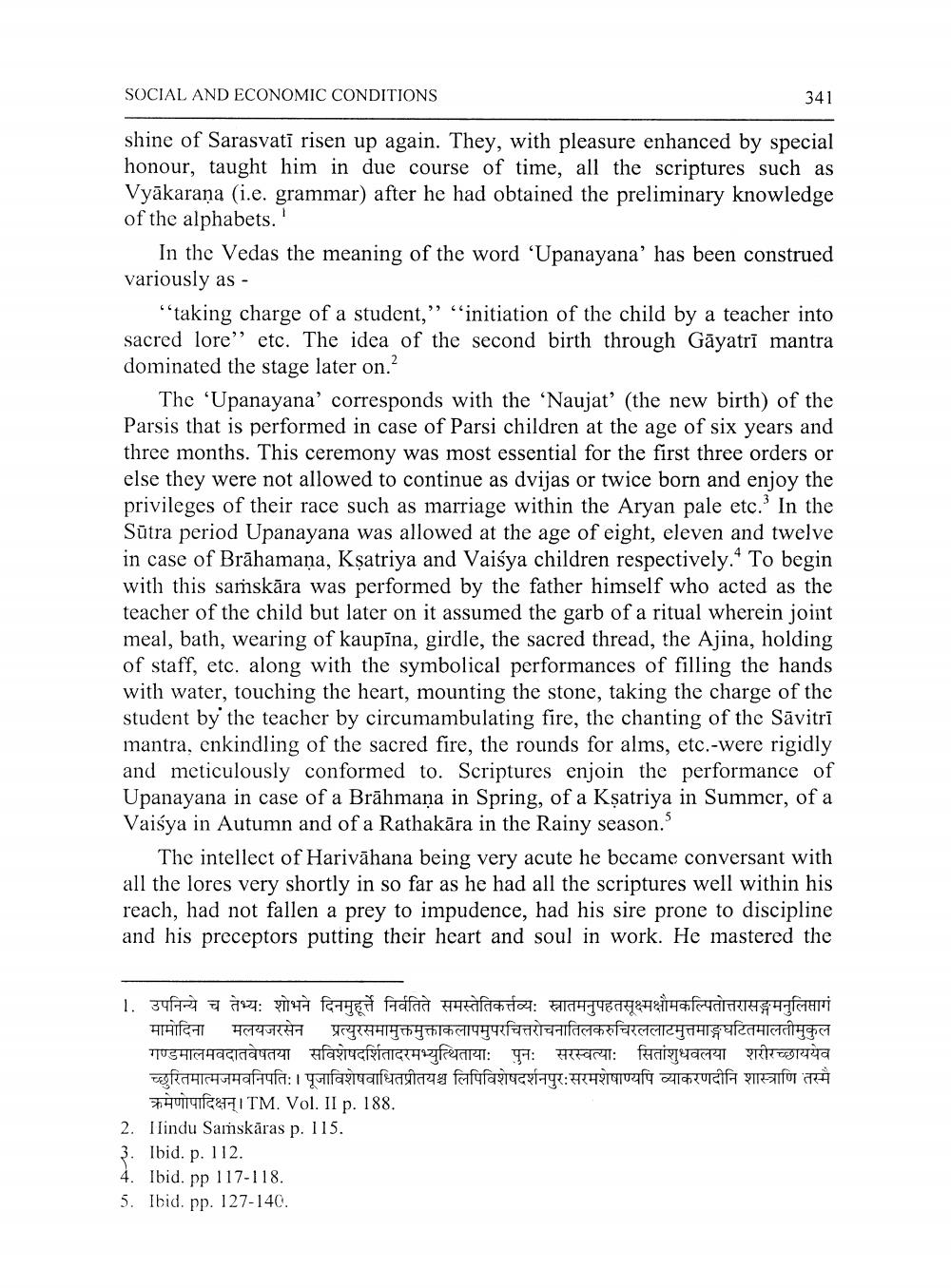________________
SOCIAL AND ECONOMIC CONDITIONS
341
shine of Sarasvati risen up again. They, with pleasure enhanced by special honour, taught him in due course of time, all the scriptures such as Vyākarana (i.e. grammar) after he had obtained the preliminary knowledge of the alphabets.
In the Vedas the meaning of the word 'Upanayana' has been construed variously as -
"taking charge of a student," "initiation of the child by a teacher into sacred lore” etc. The idea of the second birth through Gāyatrī mantra dominated the stage later on.?
The 'Upanayana' corresponds with the 'Naujat' (the new birth) of the Parsis that is performed in case of Parsi children at the age of six years and three months. This ceremony was most essential for the first three orders or else they were not allowed to continue as dvijas or twice born and enjoy the privileges of their race such as marriage within the Aryan pale etc.' In the Sūtra period Upanayana was allowed at the age of eight, eleven and twelve in case of Brāhamana, Ksatriya and Vaisya children respectively. To begin with this samskāra was performed by the father himself who acted as the teacher of the child but later on it assumed the garb of a ritual wherein joint meal, bath, wearing of kaupīna, girdle, the sacred thread, the Ajina, holding of staff, etc. along with the symbolical performances of filling the hands with water, touching the heart, mounting the stone, taking the charge of the student by the teacher by circumambulating fire, the chanting of the Sāvitri mantra, enkindling of the sacred fire, the rounds for alms, etc.-were rigidly and meticulously conformed to. Scriptures enjoin the performance of Upanayana in case of a Brāhmaṇa in Spring, of a Ksatriya in Summer, of a Vaisya in Autumn and of a Rathakāra in the Rainy season."
The intellect of Harivāhana being very acute he became conversant with all the lores very shortly in so far as he had all the scriptures well within his reach, had not fallen a prey to impudence, had his sire prone to discipline and his preceptors putting their heart and soul in work. He mastered the
1. उपनिन्ये च तेभ्यः शोभने दिनमुहूर्ते निर्वतिते समस्तेतिकर्तव्यः स्नातमनुपहतसूक्ष्मक्षौमकल्पितोत्तरासङ्गमनुलिप्तागं
मामोदिना मलयजरसेन प्रत्युरसमामुक्तमुक्ताकलापमुपरचित्तरोचनातिलकरुचिरललाटमुत्तमाङ्गघटितमालतीमुकुल गण्डमालमवदातवेषतया सविशेषदर्शितादरमभ्युत्थितायाः पुनः सरस्वत्याः सितांशुधवलया शरीरच्छाययेव च्छुरितमात्मजमवनिपतिः। पूजाविशेषवाधितप्रीतयश्च लिपिविशेषदर्शनपुर:सरमशेषाण्यपि व्याकरणदीनि शास्त्राणि तस्मै
*444&ITM. Vol. II p. 188. 2. llindu Samskāras p. 115. 3. Ibid. p. 112. 4. Ibid. pp 117-118. 5. Ibid. pp. 127-140.




